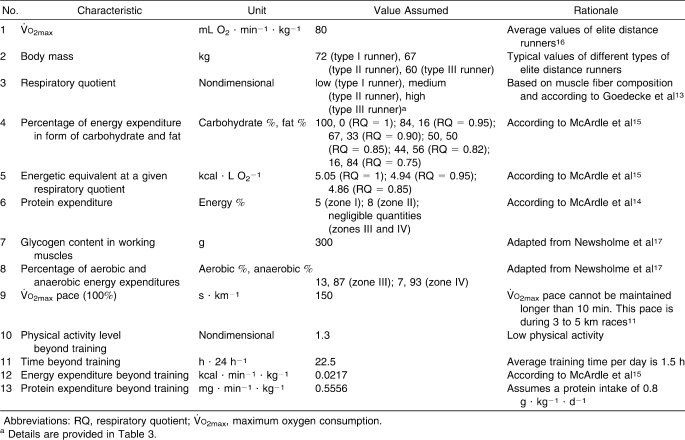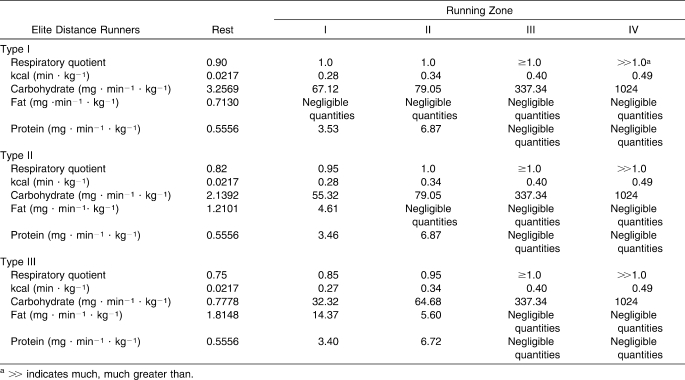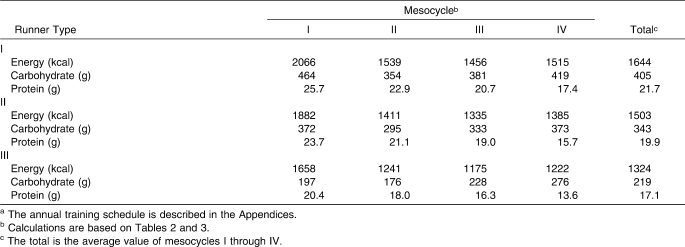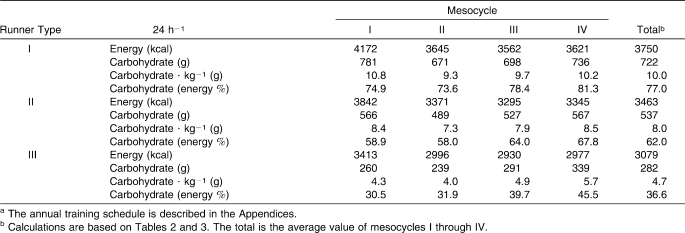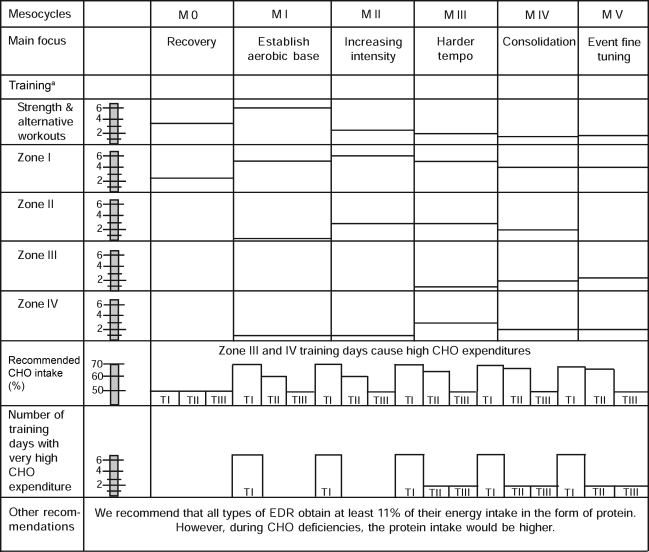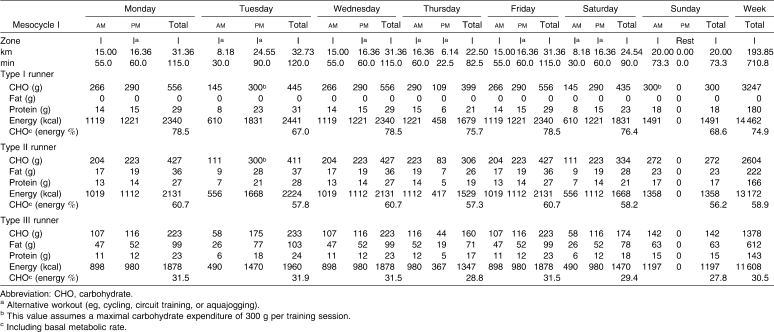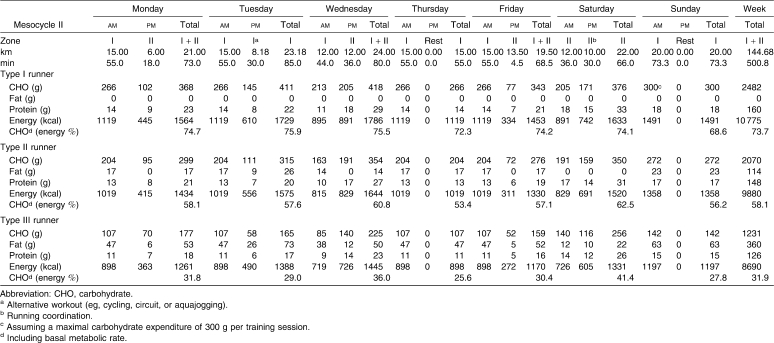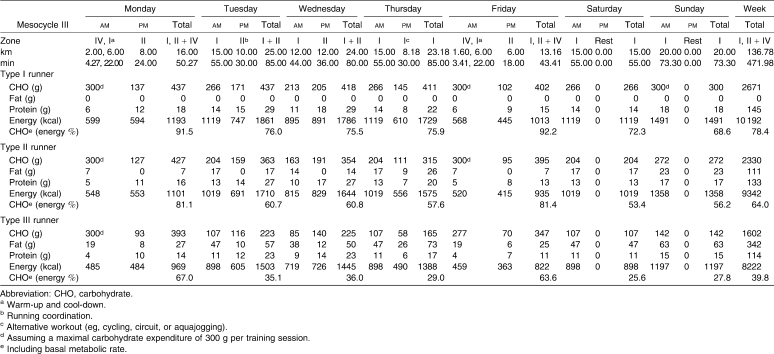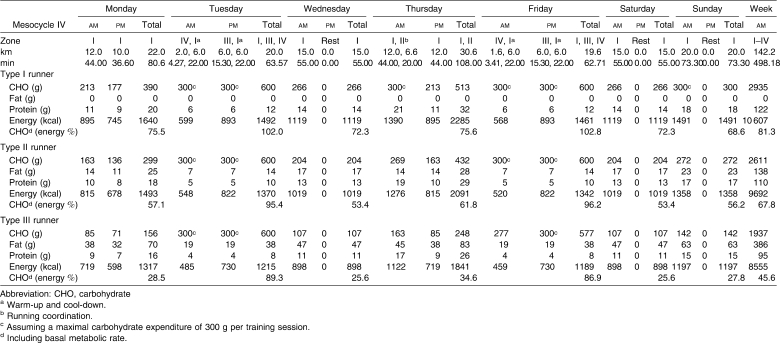Abstract
Context:
Elite distance runners (EDR) must optimize their nutrition to maintain their demanding training schedules.
Objective:
To develop a nutrition concept for EDR based on energy and macronutrient expenditures.
Design:
This theoretical study provides calculations for macronutrient and energy expenditures of EDR. Anthropometric and metabolic characteristics of EDR were assumed based on average real EDR.
Setting:
University of Kiel.
Patients Or Other Participants:
Three prototypic types of male EDR described in the literature as type I (TI; body mass = 72 kg, respiratory quotient = 0.9 at rest, fast-twitch muscle fibers = 60% to 70%), type II (TII; body mass = 67 kg, respiratory quotient = 0.82 at rest, fast-twitch muscle fibers = 50%), and type III (TIII; body mass = 60 kg, respiratory quotient = 0.75 at rest, fast-twitch muscle fibers = 30% to 40%).
Main Outcome Measure(s):
We calculated the macronutrient and energy expenditures of the 3 types of EDR according to body mass, respiratory quotient, and percentage of fast-twitch muscle fibers.
Results:
We found that the average energy expenditure was 3750 kcal · d−1 for TI runners, 3463 kcal · d−1 for TII runners, and 3079 kcal · d−1 for TIII runners. The carbohydrate (CHO) expenditure reached an average value of 10.0 g · kg−1 · d−1 for TI runners, 8.0 g · kg−1 · d−1 for TII runners, and 4.7 g · kg−1 · d−1 for TIII runners. When the EDR accomplished running sessions at a pace ≥100% of maximum oxygen consumption, all types of runners had a CHO demand of about 10 g · kg−1 · d−1. The TI and TII runners need a CHO intake of 8 to 10 g · kg−1 · d−1. For the TIII runners, a CHO intake >6 g · kg−1 · d−1 is necessary during anaerobic training sessions.
Conclusions:
Nutrition concepts must be differentiated for EDR according to metabolic and anthropometric characteristics of the runners and their special training emphases.
Keywords: diet, endurance; sports
Key Points.
Carbohydrate and energy expenditures differed among types of runners and were very high for all runners during training sessions with a pace ≥100% of maximum oxygen consumption.
During all training phases, type I runners should consume at least 70% of total energy from carbohydrates; type II runners, 60% to 65%; and type III runners, 50%.
Type I runners, who have large carbohydrate expenditures, are at risk for not taking in enough energy from carbohydrates.
Type II and III runners have larger carbohydrate needs during training in mesocycles III through V.
Nutrition education during out-of-season periods can teach elite distance runners how to apply dietary recommendations to their training.
When elite distance runners (EDR) compete, the margin between winning and losing can be extremely small. For example, during the Games of the XXVIII Olympiad in 2004, the winner of the men's 5000-m competition finished with a running time of 13:14:39 minutes; the runner-up, 13:14:59 minutes; and the last runner, 14:02:01 minutes.1 Because the margin is small, EDR whose competition distances range from 800 m to marathon have to exhaust their maximal physiologic and psychological potential. The use of regeneration measures (eg, sauna), medical care, and adequate rest sessions are also crucial for EDR. In addition, EDR must follow an optimized nutrition program to maintain their training schedules, which are characterized by a running load between 100 and 250 km · wk−1 and 2 to 3 running sessions per day.2 General nutrition recommendations in competitive sports3–10 are not sufficient for athletes with this type of training schedule. Therefore, the purpose of our study was to develop nutrition concepts for EDR based on energy and macronutrient expenditures. Our concept was based on biochemical principles.11,12
Methods
Approach
Findings in the literature2,11,13–16 and our knowledge of typical metabolic characteristics (eg, respiratory quotient [RQ]; Tables 1–3) enabled us, through 11 equations, to calculate the macronutrient and energy expenditures of 3 prototypic types of runners during 4 running intensity zones. The obtained values were applied to a typical annual training schedule (Table 4 and Appendices) to identify training situations during which athletes have specific nutrition requirements and need nutrition recommendations.
Table 1.
Values Employed for Calculations
Table 2.
Characteristics of Rest and Running Zones I through IV
Table 3.
Expenditure of Energy and Macronutrients in Different Types of Elite Distance Runners During Rest and Running Zones
Table 4.
Running Load as Mean in Kilometers per Week (%) During Each Training Zone and Mesocycle of Elite Distance Runners Based on an Annual Training Schedulea
Types of Elite Distance Runners
The classifications of EDR correspond with different physiques, body masses, RQs,13 and muscle fiber contents16 of typical EDR.18 The type I (TI) runner has large proportions (60%–70%) of fast-twitch glycolytic fibers and fast-twitch oxidative (FTO) fibers in the leg muscles. The type II (TII) runner tends to have equal proportions of slow-twitch (ST) and fast-twitch (FT) fibers. The type III (TIII) runner typically has a large proportion (60%–70%) of fatigue-resistant ST fibers. Compared with FT fibers, ST fibers exhibit larger mitochondria and myoglobin content, less myosin adenosine triphosphatase activity, more capillary density, and more glycogenolytic activity, and they express the M-isoform of lactate dehydrogenase. Among others, these metabolic differences result in high RQs for TI runners, medium RQs for TII runners, and low RQs for TIII runners during rest and running training (Tables 2 and 3).
Training Zones
The definitions of training zones (Tables 1–3) are based on the training concepts developed by Martin and Coe11 and the German Track and Field Athlete Association (Deutscher Leichtathletik Verband).12 Zone I (ZI) involves aerobic conditioning, basic endurance training I, base work, and distance running; zone II (ZII), anaerobic conditioning, basic endurance training II, and pace training; zone III (ZIII), aerobic capacity, high-intensity, long speed, and long interval training; and zone IV (ZIV), anaerobic capacity, speed, short speed, and short interval training. The running pace in ZI through ZIV is expressed in percentage of maximum oxygen consumption (V̇o2max) pace (Tables 2 and 3).11
Mesocycles
Mesocycles are training periods over 4 to 12 weeks with special training emphasis (eg, 8 weeks with focus on anaerobic training sessions). The M0 serves as a recovery period; MI through MIV, as the main cycles; and MV, as the final adaptation period before competition.
Calculations
We used 11 equations to calculate energy (Equations 2 and 7), protein (Equations 3 and 9), carbohydrate (CHO) (Equations 4, 6, 8, and 10), and fat (Equations 5 and 11) expenditures during and after the training. Calculations were based on oxygen expenditure (Equation 1); percentage of CHO and fat expenditure (RQ); and standard energy values of protein (4 kcal · g−1), CHO (4 kcal · g−1), and fat (9 kcal · g−1).
Oxygen expenditure during ZI through ZIII training was calculated using the following formula:
 |
1 |
Energy expenditure during ZI through ZIII training was calculated using the following formula:
 |
2 |
where mL O2 is the value calculated with Equation 1 and the RQ equals an assumed value given in Table 1, No. 4.
Protein expenditure during ZI and ZII training was calculated using the following formulas:
 |
3a |
where kcal · min−1 · kg−1 is the value calculated with Equation 2 and protein expenditure is expressed as energy percentage.
 |
3b |
where kcal protein is the value calculated with Equation 3a.
Carbohydrate expenditure during ZI and ZII training was calculated using the following formula:
 |
4 |
where kcal · min−1 · kg−1 is the value calculated with Equation 2, kcal protein is the value calculated with Equation 3a, and CHO expenditure is expressed as energy percentage.
Fat expenditure during ZI and ZII training was calculated using the following formula:
 |
5 |
where kcal · min−1 · kg−1 is the value calculated with Equation 2, kcal protein is the value calculated with Equation 3a, and fat expenditure is expressed as energy percentage.
Carbohydrate expenditure during ZIII training was calculated using the following formulas:
 |
6a |
where kcal · min−1 · kg−1 is the value calculated with Equation 2 and aerobic CHO expenditure is an assumed value given in Table 1, No. 8, and is expressed as aerobic percentage.
 |
6b |
where kcal · min−1 · kg−1 is the value calculated with Equation 2 and aerobic CHO expenditure is an assumed value given in Table 1, No. 8, and is expressed as anaerobic percentage. Note that the CHO expenditure is 19 times higher for the anaerobic energy production than for the aerobic energy production.
 |
6c |
where mg aerobic · min−1 · kg−1 is the value calculated with Equation 6a and mg anaerobic · min−1 · kg−1 is the value calculated with Equation 6b.
Energy expenditure during ZIV training (120% of V̇o2max pace) was calculated using the following formula:
 |
7 |
CHO expenditure during ZIV training was calculated using the following formulas:
 |
8a |
where kcal · min−1 · kg−1 is the value calculated with formula 7 and aerobic CHO expenditure is an assumed value given in Table 1, No. 8, and is expressed as aerobic percentage.
 |
8b |
where kcal · min−1 · kg−1 is the value calculated with formula 7, and aerobic CHO expenditure is an assumed value given in Table 1, No. 8, and is expressed as anaerobic percentage. Note that the CHO expenditure is 19 times higher for the anaerobic energy production than for the aerobic energy production.
 |
8c |
where mg aerobic · min−1 · kg−1 is the value calculated with formula 8a and mg anaerobic · min−1 · kg−1 is the value calculated with formula 8b.
Protein expenditure after the training was calculated using the following formula:
 |
9 |
where 0.5556 mg · min−1 · kg−1 is an assumed value given in Table 1, number 13.
Carbohydrate expenditure after the training was calculated using the following formula:
 |
10 |
where kcal · min−1 · kg−1 is an assumed value given in Table 1, number 12; kcal protein is the value calculated with formula 9; and CHO expenditure is expressed as energy percentage.
Fat expenditure after the training was calculated using the following formula:
 |
11 |
where kcal · min−1 · kg−1 is an assumed value given in Table 1, No. 12; kcal protein is the value calculated with formula 9; and fat expenditures is expressed as energy percentage.
Results
Carbohydrate Expenditure During Zone I Training
Virtually all EDR divide their running training into ZI through ZIV (Tables 2 and 3).2 The ZI training is accomplished at about 70% of V̇o2max pace and improves the development and recruitment of ST fibers, the oxidative metabolic capabilities of cardiac and skeletal muscles, the gene expression and the activity of oxidative enzymes, the mitochondrial content of skeletal muscles, and the capillary density of the heart and skeletal muscles. The resulting increase in the arteriovenous oxygen difference in ST and FTO fibers augments the use of intramuscular triacylglycerols and decreases RQ during ZI and ZII training, especially in TII and TIII runners. The calculation of CHO expenditure during ZI training (Table 3) revealed oxidation rates of 67.12 mg CHO · min−1 · kg−1 in TI runners, 55.32 mg CHO · min−1 · kg−1 in TII runners, and 32.32 mg CHO · min−1 · kg−1 in TIII runners.
Carbohydrate Expenditure During Zone II Training
The ZII training2 is intensity oriented and involves the lactate-ventilatory threshold (Table 2). It stimulates the development of ST and FTO fibers, promotes up-regulation of glycolytic and oxidative enzymes in the working muscles, augments the V̇o2max by increasing the maximal cardiac output, and improves the lactate threshold. As a result, the EDR sustain a pace of about 85% of V̇o2max up to 60 minutes in a single training session. This is accompanied by hypoxia and acidity within the working muscles, which leads to a preferential use of glycogen and to a higher RQ during ZII training than during ZI training. For ZII training, we found that CHO expenditures reached 79.05 mg · min−1 · kg−1 in TI and TII runners and 64.68 mg · min−1 · kg−1 in TIII runners (Table 3).
Carbohydrate Expenditure During Zone III and IV Training
Training in ZIII and ZIV consists of shorter distance intervals, with a total load of 2 to 6 km per session (Table 2). Based on V̇o2max pace, the intensity is about 100% in ZIII and 120% in ZIV training. The physiologic adaptations resulting from these training loads include the development and activation of FT and, particularly, of FTO fibers; increase in aerobic and anaerobic capacity of FT and FTO fibers; increase in cardiac stroke volume; and increase in blood-buffering capacity. Because 87% (ZIII training) and 93% (ZIV training) of the used adenosine triphosphate during these training sessions is generated by anaerobic metabolism, CHO becomes the primary contributor for energy supply.14,17 The resynthesis of glycogen from lactate is not significant in humans,19–21 so the use of CHO in ZIII and ZIV training is extremely high. For all types of runners, we calculated CHO expenditures of 337.34 mg · min−1 · kg−1 during ZIII training and 1024 mg · min−1 · kg−1 during ZIV training (Table 3).
Energy Expenditure During Zone I Through Zone IV Training
During ZI training, the calculated energy needs were 0.28 kcal · min−1 · kg−1 for TI and TII runners and 0.27 kcal · min−1 · kg−1 for TIII runners. For all types of runners, energy expenditures were 0.34 kcal · min−1 · kg−1 for ZII training, 0.40 kcal · min−1 · kg−1 for ZIII training, and 0.49 kcal · min−1 · kg−1 for ZIV training (Table 3).
Carbohydrate and Energy Expenditures Within Mesocycles of An Annual Training Schedule
The goals for the main mesocycles (MI through MIV) are the long-term maximization of physiologic responses that ZI through ZIV training induce. To calculate CHO and energy expenditure within these cycles, we applied a typical annual training schedule of EDR,12 which was characterized by 2 training sessions per day, an average running load of 155 km · wk−1, and high percentages of ZI (82.0%) and ZII (14.1%) training (Table 4 and Appendices). During all mesocycles, the average CHO energy expenditure during 2 training sessions per day reached 405 g (range, 381–464 g) for TI runners, 343 g (range, 295–373 g) for TII runners, and 219 g (range, 176–276 g) for TIII runners (Table 5). The average corresponding energy expenditures were 1644 kcal · d−1 (range, 1456–2066 kcal · d−1), 1503 kcal · d−1 (range, 1335–1882 kcal · d−1), and 1324 kcal · d−1 (range, 1175–1658 kcal · d−1), respectively. As a next step, energy and CHO expenditures beyond the training sessions were calculated. The average 24-hour CHO expenditure for all mesocycles was 722 g (range, 671–781 g) for TI runners, 537 g (range, 489–567 g) for TII runners, and 282 g (range, 239–339 g) for TIII runners (Table 6). The daily energy expenditures were 3750 kcal (range, 3621–4172 kcal), 3463 kcal (range, 3295–3842 kcal), and 3079 kcal (range, 2930–3413 kcal), respectively. Based on daily CHO and energy expenditures, we found that TI runners spent 77.0% energy in the form of CHO (range, 73.6%–81.3%), which corresponded with an average expenditure of 10.0 g CHO · kg−1 (range, 9.3–10.8 g CHO · kg−1). The TII runners spent an average of 62.0% energy in the form of CHO (range, 58.0%–67.8%), which corresponded with an average expenditure of 8.0 g CHO · kg−1 (range, 7.3–8.5 g CHO · kg−1). The TIII runners spent an average of 36.6% energy in the form of CHO (range, 30.5%–45.5%), which corresponded with an average expenditure of 4.7 g CHO · kg−1 (range, 4.0–5.7 g CHO · kg−1).
Table 5.
Average Energy, Carbohydrate, and Protein Expenditures of Different Types of Elite Distance Runners With 2 Training Sessions per Day Within Mesocycles Based on an Annual Training Schedulea
Table 6.
Average Energy and Carbohydrate Expenditures per 24 h of Different Types of Elite Distance Runners Within Mesocycles Based on an Annual Training Schedulea
Protein and Fat Expenditure During All Training Zones and Within Mesocycles of An Annual Training Schedule
Protein oxidation rates were similar among the different types of runners.14 For the 3 types of runners, calculated values ranged from 3.40 mg · min−1 · kg−1 to 3.53 mg · min−1 · kg−1 during ZI training and from 6.72 mg · min−1 · kg−1 to 6.87 mg · min−1 · kg−1 during ZII training (Table 3). Protein oxidation during ZIII and ZIV training is less than 2% of the energy expenditure,14 so we did not calculate it. The amount of protein used daily for energy production ranged from an average of 13.6 g to an average of 25.7 g, depending on the mesocycle and the type of runners (Table 5). Fat use was negligible during ZIII and ZIV training for all type of runners, because the RQ reached values of more than 1.0. Fat exhaustion in TI runners also was negligible. The TII runners oxidized fat at a rate of 4.61 mg · min−1 · kg−1 during ZI training (Table 3). In this type of runner, the average daily fat expenditure ranged from 15.7 g to 31.7 g, depending on the mesocycle (Appendices). For the TIII runner, we found fat oxidation rates of 14.37 mg · min−1 · kg−1 during ZI training and 5.60 mg · min−1 · kg−1 during ZII training (Table 3). The average daily fat use of TIII runners ranged from 48.9 g to 87.4 g, depending on the mesocycle (Appendices).
Discussion
Nutrition recommendations for intense endurance training and competition often are formulated as general guidelines,3–10 or they focus on nutrition supplements.22–24 Because these recommendations are not formulated with the extreme training load and metabolic and anthropometric characteristics of EDR in mind, different nutrition recommendations for this group of athletes are needed. To formulate an appropriate nutrition concept for EDR, the investigator must have detailed knowledge of the exact energy and macronutrient expenditure. However, no one has followed this approach. In our study, we developed a nutrition concept for EDR based on calculated macronutrient and energy expenditures during and beyond the training that occurs with an intense annual schedule. The calculations revealed major differences in expenditures, depending on the type of distance runner and the intensity of the training (Table 3). For example, we found that a TI runner spends an average of 77.0% of energy in the form of CHO each day. We calculated an average value of 62.0% of energy expenditure as CHO for a TII runner and an average value of only 36.6% of energy expenditure as CHO for a TIII runner. These findings suggest that a TI runner, who competes at high speeds and short distances, needs larger CHO intakes than a TIII runner, who competes at long distances. In addition, the macronutrient and energy expenditures depend strongly on the training zone. During ZI and ZII training, all EDR use CHO and a small portion of their protein for their energy supplies; TII and TIII runners also oxidize fat. In contrast, the energy supply of all EDR during ZIII and ZIV solely comes from the metabolism of CHO. In these training zones, the oxidation of fat and protein as fuel is very small. Therefore, the recommendations should differ according to special training emphasis during the various mesocycles.
Recommendations for Energy Intake
Because EDR are barely active outside of their training loads, the average energy expenditures of the different types of runners within MI through MIV were relatively low and were between 2930 kcal · d−1 for TIII in MIII and 4172 kcal · d−1 for TI in MI. We found that the TI runner, followed by TII and TIII runners, had the highest energy demand in all mesocycles. We found the highest average energy expenditure in MI for all types of runners, with 4172 kcal · d−1 in TI runners, 3842 kcal · d−1 in TII runners, and 3413 kcal · d−1 in TIII runners, due to the large number of ZI training sessions. Compared with the average energy expenditure in MI, the average energy expenditure in MII through MIV was at least 527 kcal · d−1 lower in TI runners, 471 kcal · d−1 lower in TII runners, and 417 kcal · d−1 lower in TIII runners. This means that MII through MIV needs for TI runners were more than 3500 kcal · d−1, for TII runners were between 3000 and 3500 kcal · d−1, and for TIII runners were less than 3000 kcal · d−1. If an average person needs an energy intake of 2500 kcal · d−1, then EDR need an additional intake of 500 to 1500 kcal · d−1. These intakes easily can be reached by following a normal diet according to the common dietary guidelines.25,26
Recommendations for Fat Intake
Although the difference in fat expenditures among the 3 types of runners is large and expenditures of 250 g · d−1 are possible, specific quantitative recommendations regarding fat intake are not necessary. Fat needs that ensure an adequate energy supply are easily met through a normal diet. Furthermore, the replacement of fat oxidized during exercise is not considered to be a key process during recovery and training adaptation.27,28
Recommendations for Protein Intake
With the highest training load, protein expenditures in M1 were 25.7 g protein · d−1 in TI runners, 23.7 g protein · d−1 in TII runners, and 20.4 g protein · d−1 in TIII runners (Table 5). These values correspond roughly with a protein expenditure of 0.35 g protein · kg body mass−1 · d−1 in all types of runners. Considering that the protein quality of a mixed diet is 70%, individual differences in protein metabolism of 1 SD (30%) and a safety margin of 30% of additional protein intake, the recommended protein intake should be about 2 times higher than the actual requirement. Regarding the recommended intake of 0.8 g protein · kg body mass−1 · d−1 of protein for healthy people who are not EDR,25,26 a protein intake of 1.5 (0.8 + 0.7) g · kg body mass−1 · d−1 would be enough for almost all physiologic situations and should be adequate for EDR. This value meets common recommendations for endurance athletes.6,14,29–31 When expressing this value as the percentage of dietary energy intake, EDR need only 11% of their energy from proteins. During MI, the energy exhaustion of the TI runner is relatively high. Under this condition, negative energy and CHO balances are possible and would cause a significantly higher oxidation of amino acids,29,31 which donate their carbon skeletons for the synthesis of glucose by the liver. Thus, protein can contribute more than 10% of the total energy production during training sessions. We recommend that diet provide 15% of energy from protein. This can be achieved easily by a mixed Western diet.25 Therefore, from a quantitative point of view, EDR do not need special recommendations regarding the amount of protein in their diet. In addition, the recommendations for the daily protein intake are the same for all types of EDR regardless of the daily training loads (ZI–ZIV). The EDR should ensure that one–third of their protein intake consists of animal food (meat, fish, and dairy products) and that two–thirds of the protein intake consists of plant food (whole grain products, vegetables, potatoes, and legumes). For example, the daily protein intake of animal food could include 100 g meat or fish, 1 egg, and 200 mL of milk or yogurt. The protein intake from plant food could include 100 g of cereal, 200 g of whole grain bread, and 200 g of legumes and vegetables.
One point of interest is the timing of protein ingestion. Researchers32–34 have shown that ingesting protein with CHO immediately after endurance exercise can promote glycogen storage. This storage could contribute to a faster recovery and better adaptation, especially in athletes who participate in many training sessions each day and week and subsequently have short recovery periods. Ingesting 0.4 g · kg−1 of protein immediately after training and 2 hours later is a common schedule that has been beneficial. Due to the decreased cellular amino acid availability and hyperinsulinemia, a well-directed protein intake can lead to a net muscle-protein accumulation35–37 and can positively affect glycogen resynthesis.
Recommendations for Carbohydrate Intake
Glycogen deficiency leads to reduced training intensity and response,38 low achievements in competitions,38 overtraining syndromes,14 low concentrations of lactate in the blood,39 high concentrations of ammonia in the blood,40–42 and higher protein expenditure for energy supply.29,31 To avoid these problems, large CHO intake for endurance athletes generally is accepted. However, our calculations revealed that the CHO expenditure during and beyond training is highly dependent on the type of distance runner and that runner's respective training zones. Therefore, recommendations regarding CHO intake must be differentiated by these important factors. Authors34,43–51 of many guidelines for CHO intake have described the beneficial effects of CHO feeding strategies, alone or in combination with protein, on the performance of 1 exercise session. In those guidelines, the authors hinted at the described differentiations; the recommendations distinguished between the CHO needs for recovery and for fuel in athletes undertaking exercise programs of moderate, high, or extreme intensity. They also referred to the body mass of an athlete in terms of grams of CHO per kilogram of body mass per day. However, no authors differentiated their recommendations regarding important factors, such as V̇o2max pace and RQ of EDR. With respect to ZIII and ZIV training during which EDR have a V̇o2max pace of 100% or more, our concept shows the importance of differentiating CHO intake based on the training zone. From a quantitative point of view, a human cannot resynthesize glycogen from lactate (Cori cycle) during anaerobic exercise.19–21 Instead, the resynthesis must occur from glucose that is derived from dietary CHO. Therefore, the CHO need for ZIII or ZIV training is significantly larger than for ZI and ZII training. This larger need should be considered in nutrition recommendations. In addition, we found large differences in CHO demand among the EDR. As noted, a TI runner, who has strength for high speeds and short distances, has a much larger demand for CHO than does a TIII runner, who performs well at long distances. The TIII runner usually meets energy needs during ZI and ZII training with fat. Therefore, his or her CHO expenditure is much lower than those of the TI runner. Because we considered all of these factors in our recommendations for an adequate nutrition intake for EDR, our concept is more precise than earlier recommendations.
Recommendations Regarding Carbohydrate Intake in Terms of Percentage of Energy Versus Grams Per Kilogram of Body Mass
The dietary guidelines for athletes are not uniform in their recommendations for CHO intake in terms of percentage of energy or CHO intake in grams per kilogram of body mass per day. General dietary guidelines provide traditional energy-ratio terminology to recommend the CHO intake of athletes. Considering their strict training schedules, EDR may need to use the recommendations for CHO intake in grams in relation to individual body mass, because this guideline provides more flexibility for their individual nutrient needs. Burke et al8 described the recommendation in terms of percentage contributions to total dietary energy intake as neither user-friendly nor strongly related to the absolute needs for fuel. Our calculations showed that the expression of CHO intake in terms of percentage of dietary energy or in grams per kilogram of body mass did not make a difference. Because energy expenditure, CHO exhaustion, and body mass are interconnected, the differences between these 2 kinds of recommendations are rather small. Thus, if EDR consume their recommended energy intake, both recommendations would apply, and a discussion is dispensable. During nutrition training, EDR should receive individual advice, and both recommendations should be taken into consideration. The athletes then could choose the recommendation that gives them the biggest advantage when applied to their daily activities and training schedules.
Recommendations for Carbohydrate Intake in Type I Runners
The TI runners exhausted 722 g CHO · d−1, or 77.0% of total energy expenditure. The CHO demand of the runners can be more than 80% of total energy expenditure in MIII and MIV, which are present on days with ZIII, ZIV, or both training sessions. However, a corresponding CHO intake of about 80% is not achievable, because high food volume and lack of time make such large CHO diets impractical to consume. Furthermore, a CHO intake of more than 70% of total energy is not recommended because, after deducting 11% of energy from protein, the intake of fat would be less than 19% of energy. With such a low fat intake, the demand for essential fatty acids would not be fulfilled. Another concern is the intake of vitamins; fat-soluble vitamins can be ingested only if the meal includes enough fat. Therefore, only CHO intakes of 65% to 70% of total energy are realizable for these athletes. In practical terms, these CHO intakes can be achieved by consuming a mixed Western diet; consuming large amounts of food with a high glycemic index, such as simple sugars and other compact forms of CHO45,52; increasing the frequency of meals and snacks3; consuming from 1 to 1.5 g CHO · kg body mass−1 from 1 to 2 hours before and after the training53,54; avoiding food with a high dietary-fiber content53,54; and choosing liquid CHO meals.55,56 The TI runners should pay attention to this high CHO consumption in MI through MIV in each training period. However, in MIII through MIV, they can benefit even more from the described recommendations. Because TI runners cannot meet their CHO needs of more than 70% of total energy, their bodies can adapt to the lower muscle glycogen stores resulting from moderate CHO intakes.57 Researchers58,59 have shown that moderate CHO intakes do not impair the training outcomes. In addition, investigators8 have shown that long-term intake of low-CHO diets causes metabolic adaptations that substantially enhance the fat oxidation during exercise and compensate for the reduced CHO availability. These adaptations may be advantageous for TI runners, because they could improve their fat oxidation rates and consequently decrease their RQ. Because muscle fibers could be created by metabolic processes, the alteration of the RQ possibly has a lasting effect.2
Recommendations for Carbohydrate Intake in Type II Runners
The TII runners exhaust an average of 58.0% of energy in the form of CHO in MIII and 67.8% of energy in this form in MIV. In MI and MII, the CHO demand is usually less than 60% of total energy expenditure. In those training phases, TII runners easily can meet their CHO needs by following common dietary guidelines.25,26 However, in MIII and MIV, the CHO supply can be critical. Due to the large number of anaerobic training units in these mesocycles, TII runners can need more than 70% of total energy from CHO on some days to achieve an ideal CHO maintenance. To realize CHO intakes of 65% to 70%, TII runners should consider consuming large amounts of CHO immediately before or after the training on those training days. To increase CHO availability, TII runners should eat from 1 to 1.5 g CHO · kg body mass−1 1 to 2 hours before anaerobic training sessions. In addition, they should eat from 1 to 1.5 g CHO · kg body mass−1 every 2 hours after these training sessions until they achieve at least 7 g CHO · kg body mass−1 to quickly recover muscle glycogen.44,45
Recommendations for Carbohydrate Intake in Type III Runners
Because TIII runners exhaust 36.6% of total energy in the form of CHO, they usually do not need large CHO intakes. We recommend an average CHO intake of 50% of energy, which is easily achievable with a normal Western diet. A larger CHO intake is only necessary during periods with ZIII and ZIV training sessions. During those training periods, the recommendations for TII runners also apply to TIII runners; they need a large CHO intake before and after anaerobic training units.
Recommended Nutrition Training: From Theory to Practice
Due to their large CHO requirements, EDR need nutrition experience to apply the calculated nutrition recommendations. They must have nutrition training to fine-tune their eating habits to their training schedules. Because EDR need much time for training and recovery during most training mesocycles, they should take part in selective nutrition training during the out-of-season mesocycle (that is, M0). The purpose of the nutrition training should be the application of our nutrition recommendations for EDR into their daily physical training schedules. The EDR can learn to calculate and acknowledge their individual nutrient requirements and to fine-tune their eating habits to meet their nutrient intake targets. Contents of the nutrition training are the basis of healthy sport nutrition, the specific knowledge of food composition, the preparation of meals, and the design of a meal plan that follows the recommendations. Furthermore, EDR learn how to complement nutrition with appropriate instant meals (when time to eat is limited) and still follow the nutrition recommendations. The nutrition training is of the highest importance for TI runners, because those athletes have the greatest risk of developing CHO deficiencies. Due to their extremely large CHO demand, they need to carefully plan their diets throughout the entire training year. These runners should give first priority to the planning of adequate CHO supplies, especially before a competition. In addition, the nutrition training should emphasize the planning of nutrition during critical training phases. Thus, all EDR need to learn how to meet their large CHO demands during periods with many ZIII and ZIV training sessions.
Application of The Concept
The Figure provides a generalized overview of our nutrition concept for EDR. For M0 through MV, the number of training sessions (ZI–ZIV and strength or alternative workouts) per week and appropriate recommendations regarding CHO and protein are represented. Based on Tables 2 and 3, our concept provides the opportunity to create individual training schedules and to calculate personal fuel expenditures. The Appendices exemplify a typical training schedule. In the beginning of the macrocycle (in M0), EDR and their trainers, physiologists, and nutrition experts plan the training schedules and the nutrition for the following training year. Most important is the design of the appropriate training schedules. According to the training schedules, the required values (kilograms, V̇o2max, RQ) for the calculation of the nutrient oxidation are determined by general performance diagnostics. If possible, a field test should be conducted with each EDR. After the designation of all values, the individual energy, CHO, and protein needs can be calculated. Critical mesocycles, training days, and training sessions subsequently can be assigned. Training days requiring that EDR give special attention to energy and CHO intakes should be noted in a training book. The recommendations must be transferred to food choices that are consistent with preferences and training schedules of the EDR. After the training schedules have been designed, EDR should receive nutrition training so that they can put these theoretical recommendations into practice.
Figure. Overview of the methodical succession of the training zones for a macrocycle. a Indicates number of training sessions per week. EDR indicates elite distance runners; CHO, carbohydrate.
Our concept also can be used for club athletes who run 80 km or more per week as well as for athletes in other endurance disciplines. However, because club athletes rarely reach the point where they could develop a nutrient deficiency, the general guidelines for athletes are sufficient for them. A balanced supply of energy, CHO, nitrogen, and other nutrients is achieved easily by adapting the common dietary guidelines, such as the reference values for nutrient intake and the 10 dietary guidelines of the German Nutrition Society,25 the United States' Recommended Daily Allowances,26 and the public food-guide pyramids. These guidelines recommend consuming 55% to 60% of total energy in the form of CHO, 30% of energy in the form of fat, and 10% to 15% of energy in form of protein.
Conclusions
In M0, all types of EDR can meet their CHO needs with an intake of 50% of total energy from CHO. In MI through MV, CHO intakes of at least 70% of total energy for TI runners, 60% to 65% of total energy for TII runners, and 50% of total energy for TIII runners are recommended. The TI runners have very large CHO expenditures at all times and consequently are at high risk of not consuming enough CHO. The TII and TIII runners on average have 2 critical training days per week in MIII through MV, during which they have larger CHO needs. Critical training days generally are training days with 1 or 2 ZIII and/or ZIV training sessions. For all types of EDR, we recommend a protein intake of 11% of total energy, with the exception of those with too low energy and/or CHO intakes.
Appendix 1. Typical Annual Training Schedule of Elite Distance Runners With Indication of the Calculated Macronutrient Oxidation as a Function of Training Zone and Type of Elite Distance Runner Within Mesocycle I
Appendix 2. Typical Annual Training Schedule of Elite Distance Runners With Indication of the Calculated Macronutrient Oxidation as a Function of Training Zone and Type of Elite Distance Runner Within Mesocycle II
Appendix 3. Typical Annual Training Schedule of Elite Distance Runners With Indication of the Calculated Macronutrient Oxidation as a Function of Training Zone and Type of Elite Distance Runner Within Mesocycle III
Appendix 4. Typical Annual Training Schedule of Elite Distance Runners With Indication of the Calculated Macronutrient Oxidation as a Function of Training Zone and Type of Elite Distance Runner Within Mesocycle IV
Footnotes
Sandra Schröder, MSc, and Alexandra Fischer, PhD, contributed to conception and design; acquisition and analysis and interpretation of the data; and drafting, critical revision, and final approval of the article. Christina Vock, MSc, contributed to analysis and interpretation of the data and critical revision and final approval of the article. Mike Böhme, MSc, Constance Schmelzer, MSc, Myriam Döpner, MSc, Olaf Hülsmann, PhD, and Frank Döring, Prof, PhD, contributed to conception and design; acquisition and analysis and interpretation of the data; and drafting, critical revision, and final approval of the article.
References
- 1.International Association of Athletics Federations. Official results, 5000 meters, men, final, XXVIII Olympic Games. http://www.iaaf.org/OLY04/results/genderM/discipline5000/combCodehash/roundCodef/index.html. Accessed November 14, 2007.
- 2.Noakes T. Lore of Running. Champaign, IL: Human Kinetics; 2003. p. xi,931. [Google Scholar]
- 3.Maughan R. The athlete's diet: nutritional goals and dietary strategies. Proc Nutr Soc. 2002;61(1):87–96. doi: 10.1079/pns2001132. [DOI] [PubMed] [Google Scholar]
- 4.Position of the American Dietetic Association, Dietitians of Canada, and the American College of Sports Medicine: nutrition and athletic performance. J Am Diet Assoc. 2000;100(12):1543–1556. doi: 10.1016/S0002-8223(00)00428-4. [DOI] [PubMed] [Google Scholar]
- 5.Economos C.D, Bortz S.S, Nelson M.E. Nutritional practices of elite athletes: practical recommendations. Sports Med. 1993;16(6):381–399. doi: 10.2165/00007256-199316060-00004. [DOI] [PubMed] [Google Scholar]
- 6.Williams C. Macronutrients and performance. J Sports Sci. 1995;13(spec no):1S–10S. doi: 10.1080/02640419508732271. [DOI] [PubMed] [Google Scholar]
- 7.Burke L.M, Cox G.R, Culmmings N.K, Desbrow B. Guidelines for daily carbohydrate intake: do athletes achieve them. Sports Med. 2001;31(4):267–299. doi: 10.2165/00007256-200131040-00003. [DOI] [PubMed] [Google Scholar]
- 8.Burke L.M, Kiens B, Ivy J.L. Carbohydrates and fat for training and recovery. J Sports Sci. 2004;22(1):15–30. doi: 10.1080/0264041031000140527. [DOI] [PubMed] [Google Scholar]
- 9.Lambert E.V, Goedecke J.H. The role of dietary macronutrients in optimizing endurance performance. Curr Sports Med Rep. 2003;2(4):194–201. doi: 10.1249/00149619-200308000-00005. [DOI] [PubMed] [Google Scholar]
- 10.Brown R.C. Nutrition for optimal performance during exercise: carbohydrate and fat. Curr Sports Med Rep. 2002;1(4):222–229. doi: 10.1249/00149619-200208000-00006. [DOI] [PubMed] [Google Scholar]
- 11.Martin D.E, Coe P.N. Training Distance Runners. Champaign, IL: Human Kinetics; 1991. pp. 115–171. [Google Scholar]
- 12.Reiss M, Baumann I, Hirsch L. Rahmen-Trainingskonzeption für den 5000-m-Lauf und 10000-m-Lauf, Anschluss- und Hochleistungsbereich. Darmstadt, Germany: Deutscher Leichtathletikverband; 2000. [Google Scholar]
- 13.Goedecke J.H, St Clair Gibson A, Grobler L, Collins M, Noakes T.D, Lambert E.V. Determinants of the variability in respiratory exchange ratio at rest and during exercise in trained athletes. Am J Physiol Endocrinol Metab. 2000;279(6):E1325–1334. doi: 10.1152/ajpendo.2000.279.6.E1325. [DOI] [PubMed] [Google Scholar]
- 14.McArdle W.D, Katch F.I, Katch V.L. Sports and Exercise Nutrition. Philadelphia, PA: Lippincott Williams & Wilkins; 2005. [Google Scholar]
- 15.McArdle W.D, Katch F.I, Katch V.L. Exercise Physiology: Energy, Nutrition, and Human Performance. 4th ed. Baltimore, MD: Williams & Wilkins; 1996. p. xliii,849. [Google Scholar]
- 16.Bangsbo J, Larsen H.B, editors. Running and Science: An Interdisciplinary Perspective. Copenhagen, Denmark: Institute of Exercise and Sport Sciences; 2001. p. 177. [Google Scholar]
- 17.Newsholme E.A, Blomstrand E, Ekblom B. Physical and mental fatigue: metabolic mechanisms and importance of plasma amino acids. Br Med Bull. 1992;48(3):477–495. doi: 10.1093/oxfordjournals.bmb.a072558. [DOI] [PubMed] [Google Scholar]
- 18.Pollock M.L, Gettman L.R, Jackson A, Ayres J, Ward A, Linnerud A.C. Body composition of elite class distance runners. Ann N Y Acad Sci. 1977;301:361–370. doi: 10.1111/j.1749-6632.1977.tb38213.x. [DOI] [PubMed] [Google Scholar]
- 19.Peters Futre E.M, Noakes T.D, Raine R.I, Terblanche S.E. Muscle glycogen repletion during active postexercise recovery. Am J Physiol. 1987;253(3 pt 1):E305–311. doi: 10.1152/ajpendo.1987.253.3.E305. [DOI] [PubMed] [Google Scholar]
- 20.Astrand P.O, Hultman E, Juhlin-Dannfelt A, Reynolds G. Disposal of lactate during and after strenuous exercise in humans. J Appl Physiol. 1986;61(1):338–343. doi: 10.1152/jappl.1986.61.1.338. [DOI] [PubMed] [Google Scholar]
- 21.Bangsbo J, Gollnick P.D, Graham T.E, Saltin B. Substrates for muscle glycogen synthesis in recovery from intense exercise in man. J Physiol. 1991;434:423–440. doi: 10.1113/jphysiol.1991.sp018478. [DOI] [PMC free article] [PubMed] [Google Scholar]
- 22.Johnson W.A, Landry G.L. Nutritional supplements: fact vs. fiction. Adolesc Med. 1998;9(3):501–513,vi. [PubMed] [Google Scholar]
- 23.Wagenmakers A.J. Amino acid supplements to improve athletic performance. Curr Opin Clin Nutr Metab Care. 1999;2(6):539–544. doi: 10.1097/00075197-199911000-00019. [DOI] [PubMed] [Google Scholar]
- 24.Wolfe R.R. Protein supplements and exercise. Am J Clin Nutr. 2000;72(suppl 2):551S–557S. doi: 10.1093/ajcn/72.2.551S. [DOI] [PubMed] [Google Scholar]
- 25.Deutsche Gesellschaft für Ernährung. Referenzwerte für die Nährstoffzufuhr. Frankfurt am Main, Germany: Umschau Braus; 2001. p. 240. [Google Scholar]
- 26.United States Department of Health and Human Services, United States Department of Agriculture, United States Dietary Guidelines Advisory Committee. Dietary Guidelines for Americans, 2005. Washington, DC: US Department of Health and Human Services and US Department of Agriculture; 2005. [Google Scholar]
- 27.Goedecke J.H, Christie C, Wilson G, et al. Metabolic adaptations to a high-fat diet in endurance cyclists. Metabolism. 1999;48(12):1509–1517. doi: 10.1016/s0026-0495(99)90238-x. [DOI] [PubMed] [Google Scholar]
- 28.Rowlands D.S, Hopkins W.G. Effects of high-fat and high-carbohydrate diets on metabolism and performance in cycling. Metabolism. 2002;51(6):678–690. doi: 10.1053/meta.2002.32723. [DOI] [PubMed] [Google Scholar]
- 29.Lemon P.W. Effect of exercise on protein requirements. J Sports Sci. 1991;9(spec no):53–70. doi: 10.1080/02640419108729866. [DOI] [PubMed] [Google Scholar]
- 30.Tarnopolsky M.A, Atkinson S.A, MacDougall J.D, Chesley A, Phillips S, Schwarcz H.P. Evaluation of protein requirements for trained strength athletes. J Appl Physiol. 1992;73(5):1986–1995. doi: 10.1152/jappl.1992.73.5.1986. [DOI] [PubMed] [Google Scholar]
- 31.Tarnopolsky M. Protein requirements for endurance athletes. Nutrition. 2004;20(7–8):662–668. doi: 10.1016/j.nut.2004.04.008. [DOI] [PubMed] [Google Scholar]
- 32.Ivy J.L, Goforth H.W, Jr, Damon B.M, McCauley T.R, Parsons E.C, Price T.B. Early postexercise muscle glycogen recovery is enhanced with a carbohydrate-protein supplement. J Appl Physiol. 2002;93(4):1337–1344. doi: 10.1152/japplphysiol.00394.2002. [DOI] [PubMed] [Google Scholar]
- 33.Berardi J.M, Price T.B, Noreen E.E, Lemon P.W. Postexercise muscle glycogen recovery enhanced with a carbohydrate-protein supplement. Med Sci Sports Exerc. 2006;38(6):1106–1113. doi: 10.1249/01.mss.0000222826.49358.f3. [DOI] [PubMed] [Google Scholar]
- 34.Burke L.M, Collier G.R, Beasley S.K, et al. Effect of coingestion of fat and protein with carbohydrate feedings on muscle glycogen storage. J Appl Physiol. 1995;78(6):2187–2192. doi: 10.1152/jappl.1995.78.6.2187. [DOI] [PubMed] [Google Scholar]
- 35.Tipton K.D, Wolfe R.R. Exercise, protein metabolism, and muscle growth. Int J Sport Nutr Exerc Metab. 2001;11(1):109–132. doi: 10.1123/ijsnem.11.1.109. [DOI] [PubMed] [Google Scholar]
- 36.Tipton K.D, Rasmussen B.B, Miller S.L, et al. Timing of amino acid-carbohydrate ingestion alters anabolic response of muscle to resistance exercise. Am J Physiol Endocrinol Metab. 2001;281(2):E197–206. doi: 10.1152/ajpendo.2001.281.2.E197. [DOI] [PubMed] [Google Scholar]
- 37.Rennie M.J, Tipton K.D. Protein and amino acid metabolism during and after exercise and the effects of nutrition. Annu Rev Nutr. 2000;20:457–483. doi: 10.1146/annurev.nutr.20.1.457. [DOI] [PubMed] [Google Scholar]
- 38.Wilkinson J.G, Liebman M. Carbohydrate metabolism in sport and exercise. In: Wolinsky I, editor. Nutrition in Exercise and Sport. Boca Raton, FL: CRC Press; 1998. pp. 63–99. [Google Scholar]
- 39.Kelman G.R, Maughan R.J, Williams C. Proceedings: the effect of dietary modifications on blood lactate during exercise. J Physiol. 1975;251(1):34P–35P. [PubMed] [Google Scholar]
- 40.Schulz H, Heck H. Ammoniak in der Leistungsdiagnostik. Dtsch Z Sportmed. 2001;52(3):107–108. [Google Scholar]
- 41.Wagenmakers A.J, Beckers E.J, Brouns F, et al. Carbohydrate supplementation, glycogen depletion, and amino acid metabolism during exercise. Am J Physiol. 1991;260(6, pt 1):E883–890. doi: 10.1152/ajpendo.1991.260.6.E883. [DOI] [PubMed] [Google Scholar]
- 42.Lowenstein J.M. The purine nucleotide cycle revisited [corrected] Int J Sports Med. 1990;11(suppl 2):37S–46S. doi: 10.1055/s-2007-1024853. [DOI] [PubMed] [Google Scholar]
- 43.Costill D.L, Sherman W.M, Fink W.J, Maresh C, Witten M, Miller J.M. The role of dietary carbohydrates in muscle glycogen resynthesis after strenuous running. Am J Clin Nutr. 1981;34(9):1831–1836. doi: 10.1093/ajcn/34.9.1831. [DOI] [PubMed] [Google Scholar]
- 44.Ivy J.L, Lee M.C, Brozinick J.T, Jr, Reed M.J. Muscle glycogen storage after different amounts of carbohydrate ingestion. J Appl Physiol. 1988;65(5):2018–2023. doi: 10.1152/jappl.1988.65.5.2018. [DOI] [PubMed] [Google Scholar]
- 45.Blom P.C, Høstmark A.T, Vaage O, Kardel K.R, Maehlum S. Effect of different post-exercise sugar diets on the rate of muscle glycogen synthesis. Med Sci Sports Exerc. 1987;19(5):491–496. [PubMed] [Google Scholar]
- 46.Neufer P.D, Costill D.L, Flynn M.G, Kirwan J.P, Mitchell J.B, Houmard J. Improvements in exercise performance: effects of carbohydrate feedings and diet. J Appl Physiol. 1987;62(3):983–988. doi: 10.1152/jappl.1987.62.3.983. [DOI] [PubMed] [Google Scholar]
- 47.Sherman W.M, Brodowicz G, Wright D.A, Allen W.K, Simonsen J, Dernbach A. Effects of 4 h preexercise carbohydrate feedings on cycling performance. Med Sci Sports Exerc. 1989;21(5):598–604. [PubMed] [Google Scholar]
- 48.Wright D.A, Sherman W.M, Dernbach A.R. Carbohydrate feedings before, during, or in combination improve cycling endurance performance. J Appl Physiol. 1991;71(3):1082–1088. doi: 10.1152/jappl.1991.71.3.1082. [DOI] [PubMed] [Google Scholar]
- 49.Coggan A.R, Coyle E.F. Carbohydrate ingestion during prolonged exercise: effects on metabolism and performance. Exerc Sport Sci Rev. 1991;19:1–40. [PubMed] [Google Scholar]
- 50.Hawley J.A, Dennis S.C, Noakes T.D. Oxidation of carbohydrate ingested during prolonged endurance exercise. Sports Med. 1992;14(1):27–42. doi: 10.2165/00007256-199214010-00003. [DOI] [PubMed] [Google Scholar]
- 51.Saris W.H, van Erp-Baart M.A, Brouns F, Westerterp K.R, ten Hoor F. Study on food intake and energy expenditure during extreme sustained exercise: the Tour de France. Int J Sports Med. 1989;10(suppl 1):26S–31S. doi: 10.1055/s-2007-1024951. [DOI] [PubMed] [Google Scholar]
- 52.Burke L.M, Collier G.R, Hargreaves M. Muscle glycogen storage after prolonged exercise: effect of the glycemic index of carbohydrate feedings. J Appl Physiol. 1993;75(2):1019–1023. doi: 10.1152/jappl.1993.75.2.1019. [DOI] [PubMed] [Google Scholar]
- 53.Coyle E.F. Timing and method of increased carbohydrate intake to cope with heavy training, competition and recovery. J Sports Sci. 1991;9(spec no):29–52. doi: 10.1080/02640419108729865. [DOI] [PubMed] [Google Scholar]
- 54.Ivy J.L. Dietary strategies to promote glycogen synthesis after exercise. Can J Appl Physiol. 2001;26(suppl):236S–245S. doi: 10.1139/h2001-058. [DOI] [PubMed] [Google Scholar]
- 55.Coleman E. Carbohydrates: the master fuel. In: Berning J.R, Steen S.N, editors. Sports Nutrition for the 90s: The Health Professional's Handbook. Gaithersburg, MD: Aspen Publishers; 1991. pp. 55–78. [Google Scholar]
- 56.Coleman E. Update on carbohydrate: solid versus liquid. Int J Sport Nutr. 1994;4(2):80–88. doi: 10.1123/ijsn.4.2.80. [DOI] [PubMed] [Google Scholar]
- 57.Sherman W.M, Wimer G.S. Insufficient dietary carbohydrate during training: does it impair athletic performance. Int J Sport Nutr. 1991;1(1):28–44. doi: 10.1123/ijsn.1.1.28. [DOI] [PubMed] [Google Scholar]
- 58.Sherman W.M, Doyle J.A, Lamb D.R, Strauss R.H. Dietary carbohydrate, muscle glycogen, and exercise performance during 7 d of training. Am J Clin Nutr. 1993;57(1):27–31. doi: 10.1093/ajcn/57.1.27. [DOI] [PubMed] [Google Scholar]
- 59.Vogt M, Puntschart A, Howald H, et al. Effects of dietary fat on muscle substrates, metabolism, and performance in athletes. Med Sci Sports Exerc. 2003;35(6):952–960. doi: 10.1249/01.MSS.0000069336.30649.BD. [DOI] [PubMed] [Google Scholar]



